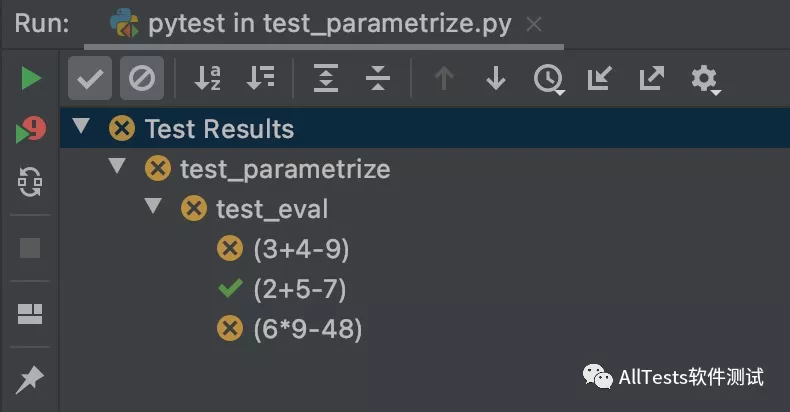目录
@pytest.mark.parametrize 允许在测试函数或类中定义多组参数和 fixtures。
参数化场景:
只有测试数据和预期结果不一样,但操作步骤是一样的测试用例是可以用上参数化的。
创建test_parametrize.py文件
示例一:未参数化
1、脚本代码:
#!/usr/bin/env python
# -*- coding: utf-8 -*-
"""
微信公众号:AllTests软件测试
"""
# 未参数化
def test_case1():
assert 3 + 4 == 9
def test_case2():
assert 2 + 5 == 7
def test_case3():
assert 6 * 9 == 48可以看到,三个用例都是先计算,然后断言某个值,重复写三个类似的用例有些冗余。
2、运行结果:


示例二:参数化(优化代码)
1、脚本代码:
#!/usr/bin/env python
# -*- coding: utf-8 -*-
"""
微信公众号:AllTests软件测试
"""
import pytest
# 参数化(优化代码)
@pytest.mark.parametrize("test_input, expected", [("3+4", 9), ("2+5", 7), ("6*9", 48)])
def test_eval(test_input, expected):
print(f"测试数据{test_input}, 预期结果{expected}")
assert eval(test_input) == expected2、运行结果:
可以看到,只有一条用例,但是利用参数化输入三组不同的测试数据和预期结果,最终执行的测试用例数还是3条,可以节省很多代码。


1、参数?
def parametrize(self, argnames, argvalues, indirect=False, ids=None, scope=None):主要参数:
(1)argnames:参数名,是个字符串,如中间用逗号分隔则表示为多个参数名。
1、创建test_parametrize2.py文件
参数名也可以是list或者tuple里的字符串。
脚本代码:
#!/usr/bin/env python
# -*- coding: utf-8 -*-
"""
微信公众号:AllTests软件测试
"""
import pytest
@pytest.mark.parametrize(["name", "pwd"], [("AllTests", "123456"), ("qq", "85135506")])
def test_case1(name, pwd):
print(name, pwd)
@pytest.mark.parametrize(("name", "pwd"), [("wangmcn", "567890"), ("admin", "123qwe")])
def test_case2(name, pwd):
print(name, pwd)
@pytest.mark.parametrize("name, pwd", [("root", "root"), ("guest", "guest")])
def test_case3(name, pwd):
print(name, pwd)2、运行结果:

(2)argvalues:参数值,参数组成的列表,列表中有几个元素,就会生成几条用例。
1、创建test_parametrize3.py文件
脚本代码:
#!/usr/bin/env python
# -*- coding: utf-8 -*-
"""
微信公众号:AllTests软件测试
"""
import pytest
# 如果只有一个参数,里面则是值的列表
@pytest.mark.parametrize("name", ["AllTests", "wangmcn", "admin"])
def test_case1(name):
print(name)
# 如果有多个参数,list包含tuple
@pytest.mark.parametrize(["name", "pwd"], [("AllTests", "123456"), ("qq", "85135506")])
def test_case2(name, pwd):
print(name, pwd)
# 如果有多个参数,tuple包含list
@pytest.mark.parametrize(("name", "pwd"), (["wangmcn", "567890"], ["admin", "123qwe"]))
def test_case3(name, pwd):
print(name, pwd)
# 如果有多个参数,list包含list
@pytest.mark.parametrize("name, pwd", [["root", "root"], ["guest", "guest"]])
def test_case4(name, pwd):
print(name, pwd)2、运行结果:

(3)ids:用例的ID。传一个字符串列表,可以标识每一个测试用例,自定义测试数据结果的显示,为了增加可读性。
注:ids的长度需要与测试数据列表的长度一致。
1、创建test_parametrize8.py文件
脚本代码:
#!/usr/bin/env python
# -*- coding: utf-8 -*-
"""
微信公众号:AllTests软件测试
"""
import pytest
my_data = [(1, 2, 3), (4, 5, 9)]
ids = ["a:{} + b:{} = expect:{}".format(a, b, expect) for a, b, expect in my_data]
@pytest.mark.parametrize("a, b, expect", my_data, ids=ids)
def test_parametrize_case(a, b, expect):
print("测试数据为{}-{}".format(a, b))
assert a + b == expect2、运行结果:


2、装饰测试类?
1、创建test_parametrize2.py文件
脚本代码:
#!/usr/bin/env python
# -*- coding: utf-8 -*-
"""
微信公众号:AllTests软件测试
"""
import pytest
my_data = [(1, 2, 3), (4, 5, 9)]
@pytest.mark.parametrize("a, b, expect", my_data)
class TestParametrize:
def test_parametrize_case1(self, a, b, expect):
print("\n测试用例case1 测试数据为{}+{}".format(a, b))
assert a + b == expect
def test_parametrize_case2(self, a, b, expect):
print("\n测试用例case2 测试数据为{}+{}".format(a, b))
assert a + b == expect2、运行结果:
当装饰器 @pytest.mark.parametrize 装饰测试类时,会将数据集合传递给类的所有测试用例方法。


3、多个参数化装饰器
一个函数或一个类可以装饰多个 @pytest.mark.parametrize
当参数化装饰器有很多个的时候,用例数等于n(个)*n(个)*n(个)*n(个)*....
1、创建test_parametrize5.py文件。
脚本代码:
#!/usr/bin/env python
# -*- coding: utf-8 -*-
"""
微信公众号:AllTests软件测试
"""
import pytest
my_data_1 = [1, 2, 3]
my_data_2 = ["a", "b"]
@pytest.mark.parametrize("a", my_data_1)
@pytest.mark.parametrize("b", my_data_2)
def test_parametrize_case(a, b):
print(f"测试数据为:{a},{b}")
2、运行结果:
参数a的数据有3个,参数b的数据有2个,所以最终的用例数有3*2=6条。


4、参数化(传入字典数据)?
1、创建test_parametrize6.py文件
数据类型为字典
脚本代码:
#!/usr/bin/env python
# -*- coding: utf-8 -*-
"""
微信公众号:AllTests软件测试
"""
import pytest
my_data = (
{
"user": "AllTests",
"pwd": "123456"
},
{
"user": "wangmcn",
"pwd": "567890"
}
)
@pytest.mark.parametrize('dic', my_data)
def test_parametrize_case(dic):
print(f'测试数据为\n{dic}')
print(f'user:{dic["user"]}, pwd:{dic["pwd"]}')2、运行结果:


5、标记参数化
pytest.param 可以传三种参数:
-
param values - 参数集值的变量 args,按顺序排列。
-
keyword marks - marks 关键字标记,要应用于此参数集的单个标记或标记列表。
-
keyword str id - 参数集的属性 id。
示例一:
1、创建test_parametrize7.py文件。
脚本代码:
#!/usr/bin/env python
# -*- coding: utf-8 -*-
"""
微信公众号:AllTests软件测试
"""
import pytest
@pytest.mark.parametrize("test_input, expected", [
("3+5", 8),
("2+4", 6),
pytest.param("6*9", 45, marks=pytest.mark.xfail),
pytest.param("6*6", 50, marks=pytest.mark.skip)
])
def test_case(test_input, expected):
assert eval(test_input) == expected2、运行结果:


示例二:
1、创建test_parametrize7_2.py文件。
脚本代码:
#!/usr/bin/env python
# -*- coding: utf-8 -*-
"""
微信公众号:AllTests软件测试
"""
import pytest
@pytest.mark.parametrize("test_input, expected", [
pytest.param("3+5", 8, id="case1"),
pytest.param("2+4", 6, id="case2"),
pytest.param("6*9", 45, marks=pytest.mark.xfail, id="case3"),
pytest.param("6*6", 50, marks=pytest.mark.skip, id="case4")
])
def test_case(test_input, expected):
assert eval(test_input) == expected2、运行结果:


6、解决unicode编码问题?
使用 @pytest.mark.parametrize 参数化的时候,加 ids 参数用例描述有中文时,在控制台输出会显示 unicode 编码问题,中文不能正常显示。
解决方法:使用 pytest_collection_modifyitems 钩子函数,对输出的 item.name 和 item.nodeid 重新编码即可。
1、创建test_parametrize9.py文件
脚本代码:
#!/usr/bin/env python
# -*- coding: utf-8 -*-
"""
微信公众号:AllTests软件测试
"""
import pytest
def login(username, password):
"登陆操作"
return {"code": 0, "msg": "success!"}
my_data = [
({"username": "AllTests", "password": "123456"}, "success!"),
({"username": "Admin123", "password": "123456"}, "success!"),
({"username": "Admin456", "password": "123456"}, "success!"),
]
ids = [
"输入正确a账号,正确密码,登录成功",
"输入正确b账号,正确密码,登录成功",
"输入正确c账号,正确密码,登录成功",
]
@pytest.mark.parametrize("input_data, expected", my_data, ids=ids)
def test_login(input_data, expected):
"测试用例-登陆"
result = login(input_data["username"], input_data["password"])
assert result["msg"] == expected2、打开命令行,输入执行命令
pytest -v test_parametrize9.py运行结果:
控制台输出中文时显示unicode编码问题。

3、解决ids参数用例描述为中文时,控制台输出显示unicode编码问题。
在项目的根目录或与用例同级目录下,创建conftest.py文件
脚本代码:
#!/usr/bin/env python
# -*- coding: utf-8 -*-
"""
微信公众号:AllTests软件测试
"""
def pytest_collection_modifyitems(items):
for item in items:
item.name = item.name.encode("utf-8").decode("unicode_escape")
# print(item.nodeid)
item._nodeid = item.nodeid.encode("utf-8").decode("unicode_escape")重新执行用例,运行结果:
控制台输出中文时显示正常。

